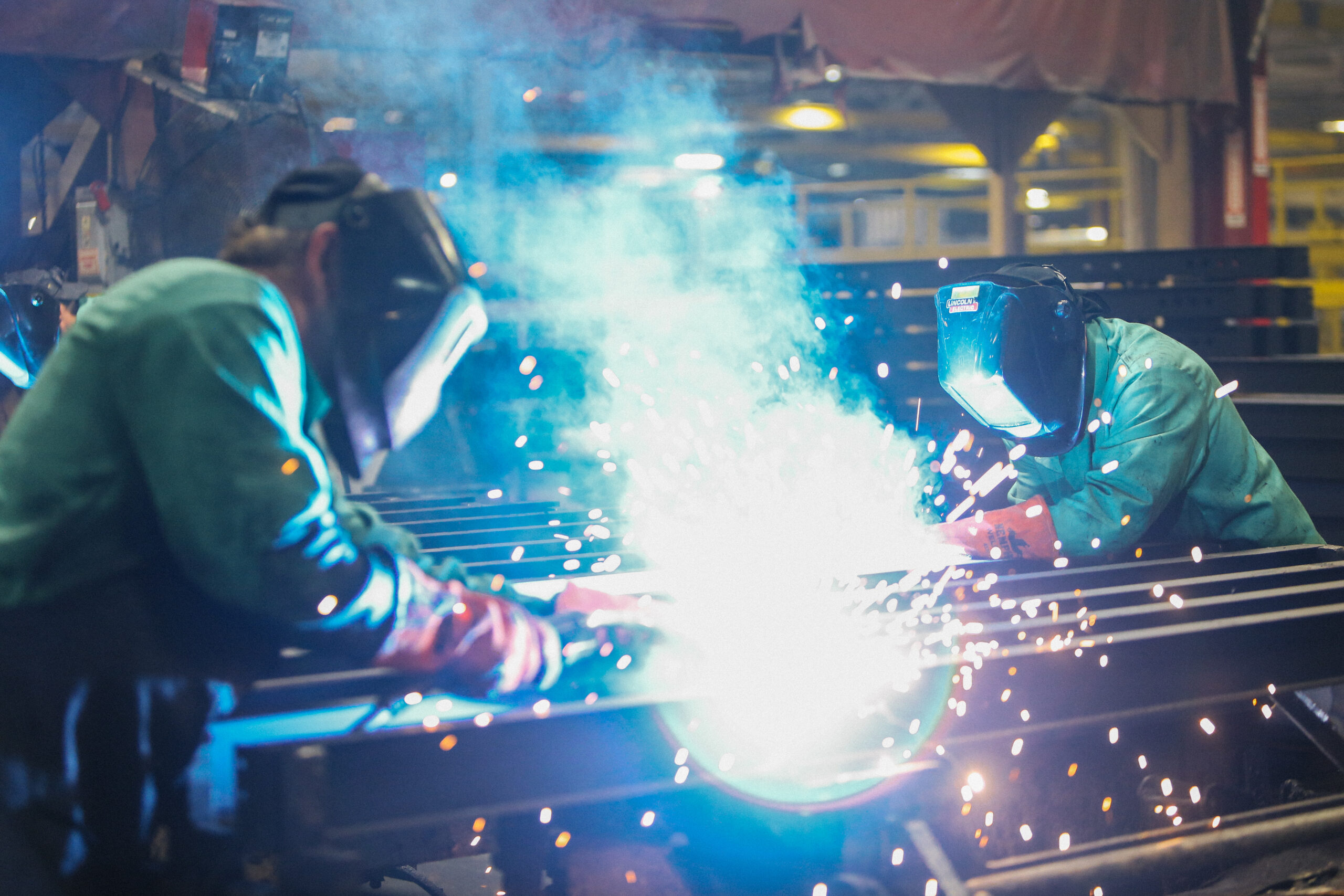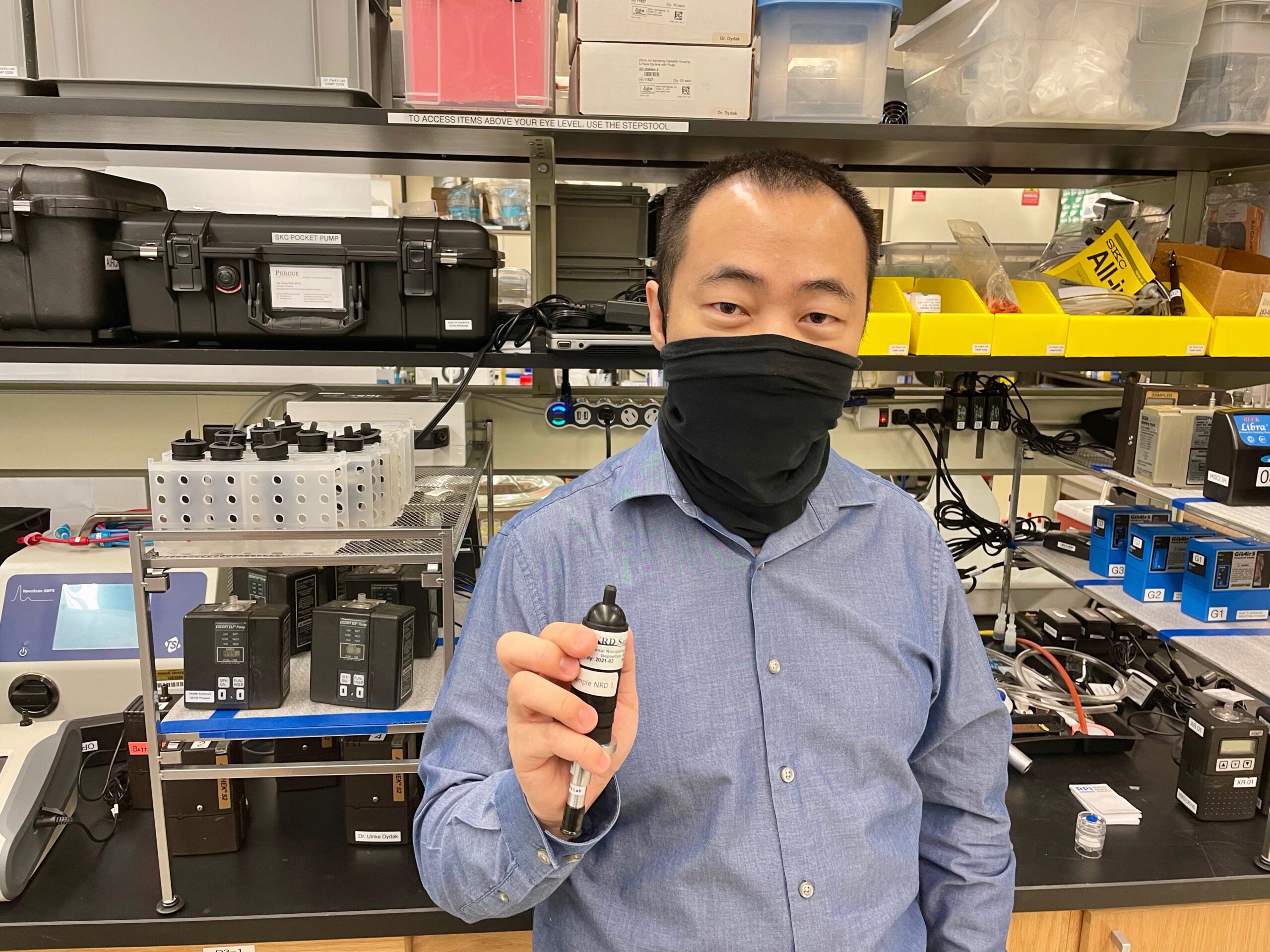Purdue HHS researchers collaborate with Wabash National for healthier workers
Written by: Tim Brouk, tbrouk@purdue.edu

Two welders work inside a Wabash National facility. The international manufacturing company is collaborating with Purdue University Health and Human Sciences researchers to enhance its workers’ safety.Photo provided
Manganese is an essential mineral for the human body, but too much could cause cognitive issues, especially when inhaled. Small amounts of manganese are emitted from welding, which is done by hundreds of thousands of workers across the United States.
Through ongoing studies, researchers in the Purdue University School of Health Sciences and the Department of Psychological Sciences collaborated with the Environmental, Health and Safety Department at Wabash National’s Lafayette, Indiana, facility with the goal of improving workers’ health.
One current project, “Neuroimaging of Manganese Toxicity,” will gather data from up to 80 welders through questionnaires; motor, mood and memory tests; and brain magnetic resonance imaging (MRI) scans. The images and data could reveal signs of neurological issues in the workers, who have been exposed to metal fumes containing manganese particulates.
“We know overexposure to manganese can lead to symptoms of motor disorders,” said Ulrike Dydak, professor of health sciences and a principal investor for the Wabash National studies. “In recent years, with occupational exposures being lower than in the past, we see more cognitive effects and even mood effects like anxiety and depression that come before any obvious motor function occurs.”
The project, which lasts through 2026, is funded by a $2.8 million grant from the National Institute of Environmental Health Sciences. The study is a continuation of a previous project, which ran from 2011 to 2018. The new work benefits from updated MRI techniques and data culled from the original study. Will tenured welders who have stepped away from the trade reveal improved MRI scans? How long is the manganese still prevalent in their brains? Are cognitive and changes reversible? Dydak will target different parts of the brain to find out.

Professor of Health Sciences Ulrike Dydak utilizes Purdue’s Life Science MRI facility to test Wabash National’s welders and to get their brains scanned.Charles Jischke
“Originally, we were able to map out where the manganese was in the brain and correlated in areas with particular cognitive functions, for example: executive functions,” Dydak said. “These people weren’t ill, but they performed less well.”
Dydak examines scans of the welders’ brains, looking for metal deposition and neurochemical changes at the Purdue Life Science MRI Facility, which just celebrated its fifth anniversary on the Purdue campus. The facility was specifically designed for human studies such as this, enabling MRI and other types of subject assessments within the same building.
“What helps us is the fact that manganese is a paramagnetic metal, which increases the signal in certain MRI images,” Dydak explained. “It creates these bright spots in the image whenever there is excess of manganese.”
The human brain can host other paramagnetic metals. Iron is another metal essential in human function where too much can be dangerous, and it can be prevalent in welding fumes, too. Iron shows up similarly on MRI scans, changing the contrast in the brain. Dydak is developing techniques that differentiate the metals in the brain.
A particular focus of the new study is to understand the dynamics of uptake and elimination of manganese in the brain. For this, some of the welders who participated in the first phase of the manganese study will be followed as well as retired welders and welding trainees new to the trade. These less experienced welders offer a “baseline” to work from.
“We will follow up with them every three months to see how the manganese is going into the brain — where it goes first, where it goes last and when you start seeing any kind of neurochemical changes and when you start seeing any kind of changes in their test performances,” Dydak said.
In healthy brains, manganese is known to be transported along nerve fibers, which constitute the white matter in the brain. Manganese’s presence has been linked to healthy brain function — at the right levels.
Dydak hypothesized when excess manganese starts showing up in specific grey matter parts of the brain, symptoms of neurological and physical impairments start to occur. Understanding when the brain burden gets too high and how long it takes for manganese to clear out of certain brain areas when stopping the exposure.
Air sampling
While Dydak is studying the neurotoxic effects on the welders, she must understand exactly what the welders are exposed to. In collaboration with Jae Hong Park, assistant professor of health sciences, the researchers have analyzed air samples extracted from numerous locations within Wabash National’s buildings in Lafayette.

Jae Hong Park, assistant professor of health sciences, used wearable air samplers of his own design to analyze what particles can be found inside a Wabash National facility in Lafayette, Indiana.Tim Brouk
Park is a certified industrial hygienist and an air sampling expert. He has developed multiple personal samplers throughout his career. He said assessing exposures to welding fumes could be the first step to protect workers’ health. However, analyzing welding fumes is not simple and requires multiple techniques.
“Welding fumes are kind of a mixture of particles and gases,” Park said. “I’m targeting those particles and analyzing the metal contents in those particles.”
The size of particles in welding fumes generally ranges between .05 and 20 micrometers. The conventional sampler can collect respirable particles — typically smaller than ten micrometers with a cutoff size of four micrometers — that can penetrate to the deep lung where gas exchange takes place. Park fixed the conventional samplers to workers’ collars or lapels to collect the air in the breathing zone, within one foot of a worker’s nose and mouth. As expected, manganese was found in the collected particles as well as iron, aluminum and other metals.
The size of particles is the most important parameter to characterize the toxicity and behavior of particles. In Park’s related study, “Nano Particulates in Welding Fumes and Manganese Deposition in the Human Brain: Does Size Matter?,” he is exploring how the size of toxic particles affects human subjects. Do smaller particles create more toxicity in the body?
To answer this question, Park used his nanoparticle respiratory deposition sampler together with the conventional sampler. The sampler contains foam that mimics the human lung structure and can collect only nanoparticulate matter smaller than 300 nanometers. The welders wore both conventional and nanoparticle respiratory deposition samplers for their entire shift. In the lab, he has analyzed the metal contents in particles collected using both samplers.
“The significant portion of welding fume is nanoparticles,” Park said. “Currently, we are targeting manganese, but we will also be looking for multiple metals. Understanding what’s inside those welding fumes, that’s the first step.”
More than trailers, more than manganese
Brent Yeagy, Wabash National president and CEO and a Purdue Health Sciences alumnus, said of Wabash National’s more than 6,000 total employees across 14 manufacturing facilities in the United States and Mexico, approximately 1,000 are welders and 1,500 more are regularly exposed to the fumes created during welding. Having Purdue close by has given his company more insight into the working environment.
“We’ve learned that the research area of how worker exposure to metal fume may lead to biological effects is incredibly complex and not relatively well-known,” Yeagy said. “It is something we are just scratching the surface on understanding and that there’s a tremendous amount of academic work that is needed to better understand to assure that we can protect our workers going forward.
“The research studies with Purdue have allowed us to refine our welding methods to give us the safest environment that we understand today. They’ve given us a more in-depth understanding of what environmental conditions and process conditions impact worker exposure, which has allowed us to be better at what we do.”
While semi-trailers are Wabash National’s largest product family, workers weld on other products, which exposes them to a variety of metal particulates and fume.
“We have welding applications that use high-grade exotic alloys in medical equipment manufacturing. We do stainless steel and other corrosion-resistant metals for chemical processing and hazardous chemical transport,” Yeagy said.
What can be done
Welding is essential for Wabash National and thousands of other companies. It cannot be replaced, but the environment of the workers can still be improved. Since the collaboration between the company and the Purdue College of Health and Human Sciences researchers, more welders are wearing respirators to filter out the fumes.
“We could learn in our study that people should be welding so many weeks or months at a time before they do something else,” Dydak said. “Depending on what we find, it could provide improved methods to manage worker exposures.”
Dydak acknowledged Wabash National’s investment in its workers well-being. In the last 10 years, the collaboration has yielded several published research initiatives with more on the way by the end of 2021. She applauded the welders themselves for their dedication to their own health, including dedicating large chunks of time to get MRIs and cognitive tests.
All of this work will ensure safer working conditions and healthier lives for Wabash National employees as well as many other manufacturing companies that utilize welders.
“I’m extremely impressed with how Wabash National is embracing that, embracing their whole idea of workers’ health and wanting to be on the forefront,” Dydak said. “We haven’t found another facility yet to be open-minded enough to let researchers like us come in and test their areas and workers.
“They do really care and make sure their people are safe.”